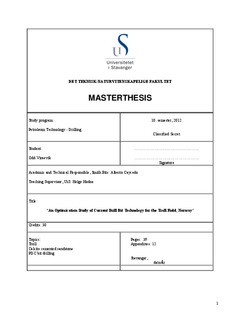| dc.contributor.author | Vinsevik, Odd | |
| dc.date.accessioned | 2014-02-06T09:38:26Z | |
| dc.date.issued | 2012 | |
| dc.identifier.citation | | no_NO |
| dc.identifier.uri | http://hdl.handle.net/11250/183652 | |
| dc.description | Master's thesis in Petroleum engineering | no_NO |
| dc.description.abstract | In the current study geology, drill bit technology and drilling challenges at the Troll Field are mapped.
It has been established that the Troll Reservoir Formation consists of unconsolidated shallow marine sandstone with highly dense calcite cemented intervals. However the occurrences of calcite cemented intervals are difficult to predict. The intervals can cause breakage to the PDC cutting structures, along with undesired high local doglegs, and low penetration rates.
Sophisticated and advanced simulation software was used to simulate and create a similar drilling environment for the targeted 8 ½“ section on Troll. Several PDC bits were simulated to determine the most optimum PDC cutting structure for Troll Drilling.
The newest iteration of the Smith Bits 8 ½ ” MDSi716LUVPX, with 5” gauge pad length, was found to be the most applicable for drilling the 8 ½” section on Troll. | no_NO |
| dc.language.iso | eng | no_NO |
| dc.publisher | University of Stavanger, Norway | no_NO |
| dc.relation.ispartofseries | Masteroppgave/UIS-TN-IPT/2012; | |
| dc.subject | petroleumsteknologi | no_NO |
| dc.subject | Troll Field | no_NO |
| dc.subject | PDC Drilling | no_NO |
| dc.title | An optimization study of current drill bit technology for the Troll Field, Norway | no_NO |
| dc.type | Master thesis | no_NO |
| dc.subject.nsi | VDP::Technology: 500::Rock and petroleum disciplines: 510::Petroleum engineering: 512 | no_NO |
| dc.description.embargo | 2017-07-01 | |
| dc.source.pagenumber | 39 | no_NO |
